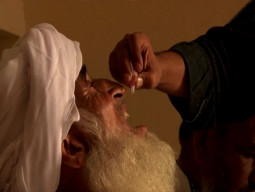
ISLAMABAD:
Zainab Bibi, 28, and her newborn, were rushed from Kotli Sattian to the Pakistan Institute of Medical Sciences (PIMS). There were complications during childbirth – she was bleeding excessively, and the child was having trouble breathing. They did not make it.
“We first took her to the Basic Health Unit (BHU) for the delivery, but no doctor was available. An untrained nurse took up her case, which lead to complications. After this, we immediately brought her to PIMS, but unfortunately, neither of the two could be saved,” recalls Razia Bibi, Zainab’s mother.
Zainab’s case is not a one-off. One of the major reasons as to why Pakistan is not on track to achieving Millennium Development Goals (MDGs) 4 and 5 – reducing child mortality and improving maternal health, respectively – is weak healthcare infrastructure that cannot ensure provision of quality service to far flung areas.
In 2009, World Health Organisation identified Pakistan as one of 57 countries facing a ‘human resources for health crisis’ which makes it unlikely to meet the MDGs by 2015.
A nation at risk
Dr Rizwana Chaudhry, head of gynaecology at the Holy Family Hospital, Rawalpindi, believes that thousands of maternal and neonatal deaths can be prevented by simple provision of basic facilities in rural areas.
“However, the main issue is that doctors and other healthcare professionals are not ready to work in rural areas,” Chaudhry explains. “They are scared to go there, due to the weak infrastructure and the lack of incentives. They don’t get proper accommodation, transport, pay raises and even educational opportunities for their kids. It’s a nightmare. ”
Dr Khadija Bano, a resident medical officer at Aga Khan Health Services in upper Hunza since 2011, sees firsthand the effects of this. She is the only doctor in the area for a population of 25,000 people, and has to be on duty 24 hours a day.
“It is terribly difficult to provide treatment to patients in the absence of pharmacies, laboratories and with very little medical staff. We feel handicapped,” she says.
Bano’s job is a tough one, to say the least. She has to travel via boat to surrounding areas, which becomes impossible during the winters, as the lakes freeze over. There is one ten-bed civil hospital in the area but it lacks professional doctors, specialists and surgeons, she says. Simply no one agrees to work in such an environment.
Reported findings
A Population Council study titled Assessing Retention and Motivation of Public Healthcare Providers in Rural Pakistan was launched just this Friday. The council conducted the study in 28 randomly selected districts within seven regions of Pakistan in an attempt to reveal the infrastructure deficiencies at BHUs and maternal& child healthcare centres (MCHs). According to its findings, only 14 per cent of the rural health centres are equipped to provide Basic Emergency Obstetric Care, and just 45 per cent of the tehsil headquarters hospitals and district headquarters Hospitals are equipped to provide Comprehensive Emergency Obstetric Care.
One-fifth of providers interviewed had not received any training, while more than half reported dissatisfaction with promotion opportunities and over a quarter were dissatisfied with the current method of annual appraisal. Political interference was also cited as a significant demotivating factor.
In this vein, Saira Afzal, the minister of state for national health services, regulations and coordination, believes that meaningful reform in healthcare cannot be achieved until workers can be attracted to work in rural areas.
Meanwhile, a report launched this past Wednesday titled ‘Lives on the Line — an agenda for ending preventable child deaths’, prepared by Save The Children, reiterated many of the Population Council’s views. According to this document, Pakistan is off track to achieving MDG 4 because of the healthcare workers crisis, which has caused poor routine immunisation coverage for preventable childhood illness and led to consistently high rates of child deaths, especially in rural and urban slums.
Published in The Express Tribune, October 27th, 2013.
COMMENTS (1)
Comments are moderated and generally will be posted if they are on-topic and not abusive.
For more information, please see our Comments FAQ






















































Govt in 2007 started a MNCH program the strategy of it was to train one community midwife in per ten thousand population. The candidate for midwifery education should be taken from the same population where she herself live. RS 20 billion where allocated to this MNCH program. But this program was Hijacked by political parties. Every provincial Government of 2008 made their blue Eyed doctors as provincial Coordinators and Interesting the Audit department persons who were send for Audit were made Finance officer. Every Ruling political party of the province used its funds for their political Activities. The program is still running in every province embezzling the remaining Fund. Every partner organization like UNICEF , UNFPA ,WHO 'USAID program like Paiman ,Pride etc DFID ,Pakistani managers of these organization were also involved in this corruption . They embezzled the money provided by these organisations to help the program. Not out put of such Huge Fund.